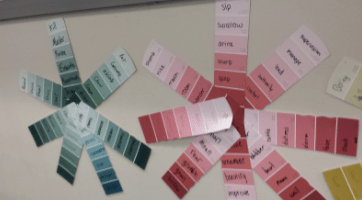Today’s guest post comes from Amy Heusterberg-Richards, a tenth-year ELA teacher at Bay Port High School in the Howard-Suamico School District, located just north of Green Bay, Wisconsin. Amy currently teaches Writing 10 and IB English Literature HL Year Two. Connect with her on Twitter at @LAwithMrsHR.
Mentor Texts:
- “Toolbox” pages 111-118 from On Writing by Stephen King (Diction)
- “Toolbox” pages 118-128 from On Writing by Stephen King (Syntax)
- “Imagery and the Third Eye” by Stephen King (Imagery)
- “Short Assignments” from Bird by Bird by Anne Lamott (Details)
Writing Techniques:
- Reflecting on elements of craft
- Creating voice
Background:
My fifth-grade Social Studies teacher had a head of hair that rivaled those of Michael Bolton and Kenny G (musical studs of the time), making him the subject of more than one conversation between my classmates’ mothers. He had an acoustic guitar on which he played historical ballads and an impressive collection of obnoxious ties. An apparent pioneer in flexible seating, he had a reading loft and colorful bean bag chairs, over both of which we students often fought. All these glorious items aside, though, the possessions I most remember from Mr. Weitzel’s school domain were his classroom walls, spaces filled with explorers’ names, vocabulary terms, and worldly locations.
At the beginning of the school year, the walls were unimpressive, white blocks spattered with grey smudges and sticky, tape residue. Come June, however, they transformed into an exhibition of all the learning we students had accomplished. I remember sitting at my desk those last days and feeling a proud satisfaction of all the terms I had acquired, all the people and places I could now discuss. Mr. Weitzel, as primary school teachers perhaps best understand, knew the impact these Word Walls had on the development of his students. He used his walls to physicalize terms, to track concepts, and to serve as reference documents. He skipped posters to motivate and instead posted words to guide.
This school year in our tenth-grade Writing course, my teammates and I decided to re-write the seemingly elementary Word Wall concept at our secondary level. We knew we wanted to begin our class with an exploration of — to borrow language from Stephen King’s On Writing — the “tools” of effective craft. We selected five elements of voice (diction, syntax, imagery, inclusion/exclusion of details, and tone) which we felt we could use in all upcoming writing studies. We also decided, in the spirit of the Word Wall, to post visuals of each tool on our own walls for “Writing Well.”
How We Used The Mentor Texts:
For each writing tool, we asked students to define the device and study a teacher-selected mentor text whose purpose was twofold: The excerpt from King’s On Writing (chapter one of the “Toolbox” section) described how to select vocabulary, but students also discussed how King employed the diction tool himself; Anne Lamott’s “Short Assignments” from Bird by Bird advised how to include/exclude details, but the class analyzed how her writing gave/withheld information with intent, too.
After exploring such mentor texts by writers-on-writing, we asked students to discuss additional examples of each tool’s use in groups and practice writing these devices in pairs. Ultimately, we ended each two-day, tool study with an individual activity that prompted students to intentionally use the element of craft to write well and, at the same time, to produce a visual to adorn our Writing Well Wall.
- For diction, each student selected words with similar denotative meanings and placed them on a spectrumed paint sample with consideration to connotation.

- For syntax, each student selected an auditory sound and visually wrote syntax that mimicked its quality and color.

- For imagery, each student selected a photograph and wrote the sensory experience of one of its human subjects.

- For details, each student selected a topic about which to write a flip-book riddle that excluded enough details to confuse but not enough to stump.

- For tone, each student pulled a page from a discarded library book, marked evidence that created a tone, and labeled/showed the tone word.

The entire study of these five writing tools took the initial two weeks of our course. In that short time, our Writing students studied, practiced, and mimicked the craftsmanship of strong writers at a wonderfully tangible level. They created a wall full of examples showcasing the tools used to produce effective craft. Greater even still, they developed testimonies to themselves that they can control, at this most focused level, the sometimes daunting tasks needed to write effectively. As we move on to more challenging topics, more developed essays, and longer revision periods, I hope my students feel a comforting satisfaction — not unlike the one fifth-grade me experienced — as they sit aside a Writing Well Wall that reminds them with each glance that they can use — and have used — the tools of powerful writers.


1 Comment